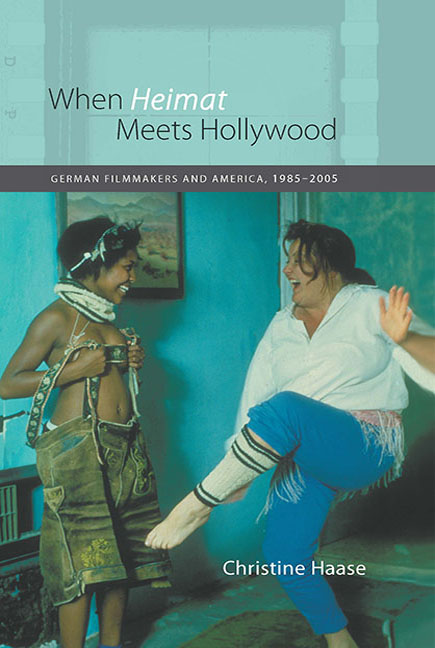Book contents
- Frontmatter
- Dedication
- Contents
- Acknowledgments
- Introduction
- 1 German and American Film Relations in the Twentieth Century
- 2 Wolfgang Petersen: Blockbuster Auteur?
- 3 “Foil, Toothpaste, ID4”: Ideology and Global Appeal in the Films of Roland Emmerich
- 4 Crossing Boundaries, Connecting People: The German-American Films of Percy Adlon
- 5 “Bambi, Zombie, Gandhi”: The Cinema of Tom Tykwer
- Conclusion
- Works Cited
- Index
5 - “Bambi, Zombie, Gandhi”: The Cinema of Tom Tykwer
Published online by Cambridge University Press: 11 May 2017
- Frontmatter
- Dedication
- Contents
- Acknowledgments
- Introduction
- 1 German and American Film Relations in the Twentieth Century
- 2 Wolfgang Petersen: Blockbuster Auteur?
- 3 “Foil, Toothpaste, ID4”: Ideology and Global Appeal in the Films of Roland Emmerich
- 4 Crossing Boundaries, Connecting People: The German-American Films of Percy Adlon
- 5 “Bambi, Zombie, Gandhi”: The Cinema of Tom Tykwer
- Conclusion
- Works Cited
- Index
Summary
“Aber das Eigene muß so gut gelernt sein wie das Fremde.”
— Friedrich HölderlinTom tykwer IS one of the nationally and internationally most prominent and successful German directors to have emerged from the country since the fall of the Berlin Wall in 1989. The multitalented composer, musician, producer, writer, and director burst onto the international film scene in 1998 with the independent hit Lola rennt (Run Lola Run). The movie was an instant success with critics and audiences around the globe, a surprising achievement for a young German director who, up to that point, had made just two feature films, Die tödliche Maria (Deadly Maria, 1993) and Winterschläfer (Winter Sleepers, 1997).
Lola rennt catapulted its creator and lead actors into instant national and transnational stardom. This was especially true of Franka Potente, who played Lola, as evidenced by her roles as Johnny Depp's girlfriend in Blow (Ted Demme, 2001) and as Matt Damon's leading lady in The Bourne Identity (Doug Liman, 2002) and The Bourne Supremacy (Paul Greengrass, 2004). American critics pronounced Lola to be a “festival circuit smash hit from Germany that's already become a pop culture phenomenon in Europe,” and called it a “hyperkinetic pop culture fire cracker.” In Australia, Tykwer was hailed as belonging “to the new generation of German film-makers who have managed that rare feat: to make domestic productions that have mass appeal.”
The film's popular and critical acclaim demonstrated its resonance with the movie-going public and reviewers alike. This resonance was certainly based in part on Lola's finely tuned — and timely — pop cultural and postmodern sensibilities: its MTV-style aesthetics, rushing soundtrack, video game framework, and its two hip, tattooed, and deeply romantic protagonists. Moreover, the production in many ways epitomizes Tom Tykwer's cinematic strategies for globalizing national films. These strategies are based on the successful fusion of German and American filmmaking in movies that allow for Hollywood pleasure without giving up their Heimat identity. Critics recognized this quality in Lola: one Australian reviewer applauded the film for opposing Hollywood tactics, asserting that “it's nice to see a film that is as commercially appealing as this one, without Hollywood's googol-eyed influence or over the top effects”; another urges audiences to see it for the opposite reason: “For anyone who wants to try foreign cinema for the first time, this is about as close to Hollywood as you can get.”
- Type
- Chapter
- Information
- When Heimat Meets HollywoodGerman Filmmakers and America, 1985–2005, pp. 162 - 196Publisher: Boydell & BrewerPrint publication year: 2007

